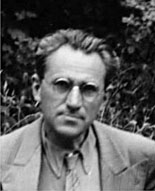
Born in 1888 in Bougourouslan, Serge Charchoune attended academies in Moscow before arriving in Paris in 1912 where he worked with Le Fauconnier at the independent Académie de la Palette. That same year he submitted work for the first time to the Salon des Indépendants. His first one-man show in Paris was at the Galerie Fournet in 1920. In 1921 - 1922 Charchoune joined the radical Dada movement, participating in their group exhibitions and contributing to a number of their reviews. In 1922 he also visited Berlin and held a one-man exhibition in the famous Der Sturm gallery. Having returned to Paris the critic André Salmon introduced him to the gallerist Jeanne Bucher who showed his work in 1926. Around the same time Charchoune also met the Purist artist Ozenfant. Charchoune began to introduce the rigorous structure of Purism to his own irreverent and inventive approach. Creating compositions that alternated between lyrical organic forms and more geometrically ordered ones, which with typical Dadaist wit he dubbed Paysages Elastiques, or Cubisme Ornemental. His early experimentation with various æsthetic approaches would culminate in the acclaimed series of the post-war years: Cycles Marins, Les Hommages, and Compositions Musicalistes of which the present work is a wonderful example.
In 1935 he Charchoune began to analyse the relationship between art and music, which became the inspiration for the delicate monochrome abstracts of his mature period. “Music gives me the theme. While listening to music, I see the painting with my eyes closed, like a coloured seam stretching out before me” (Charchoune, interview with Michel Ragon, Paris, 1966). Charchoune’s greatest achievement is perhaps the spontaneous sense of wonder which emanates from his compositional complexity. “Some of his best canvases owe their inspiration to the music of Bach or Beethoven, although this fact adds nothing to their obvious plastic qualities. (...). His work reaches unequalled heights of delicacy in modulations of a single colour. These pictures, which are a kind of spiritual exercise for the eye, must be numbered among the best examples of pure painting” (M. Seuphor, 1958).
Charchoune received great critical acclaim during his career and exhibited extensively in France and abroad, including in Barcelona, Stockholm, Brussels, New York, Geneva and Prague; and a major retrospective of his work was held at the Musée National d’Art Moderne, Centre Georges Pompidou, Paris in 1971, the Pouchkine Museum, Moscow, 2006; and the Russian Museum in St Petersburg.
The artist is represented in numerous museums of modern art including in France notably the Musée National d’Art Moderne, Centre Georges Pompidou, Paris, the Musée d’Art Moderne de la Ville de Paris and the Musée d’Art Moderne, Lille.